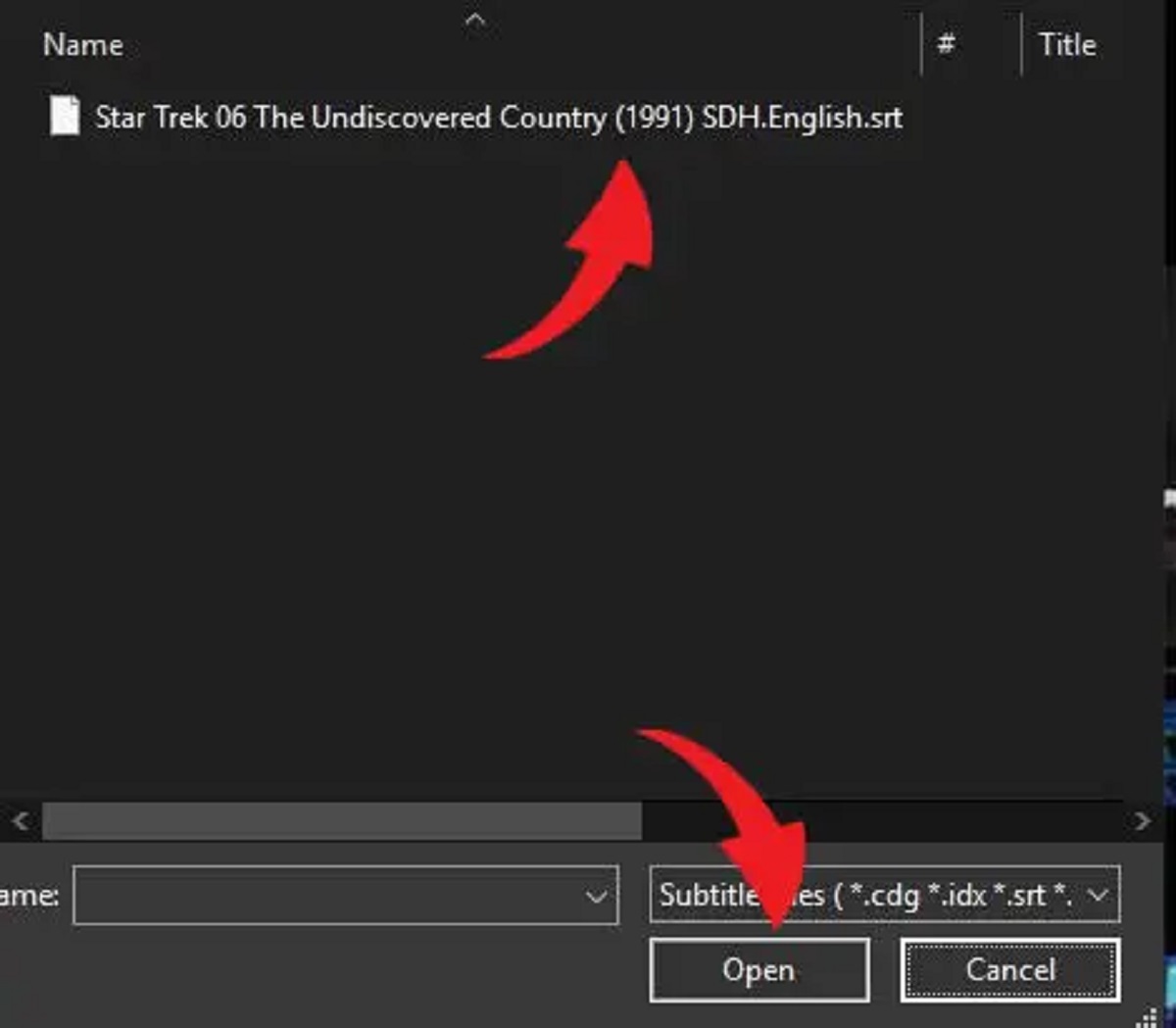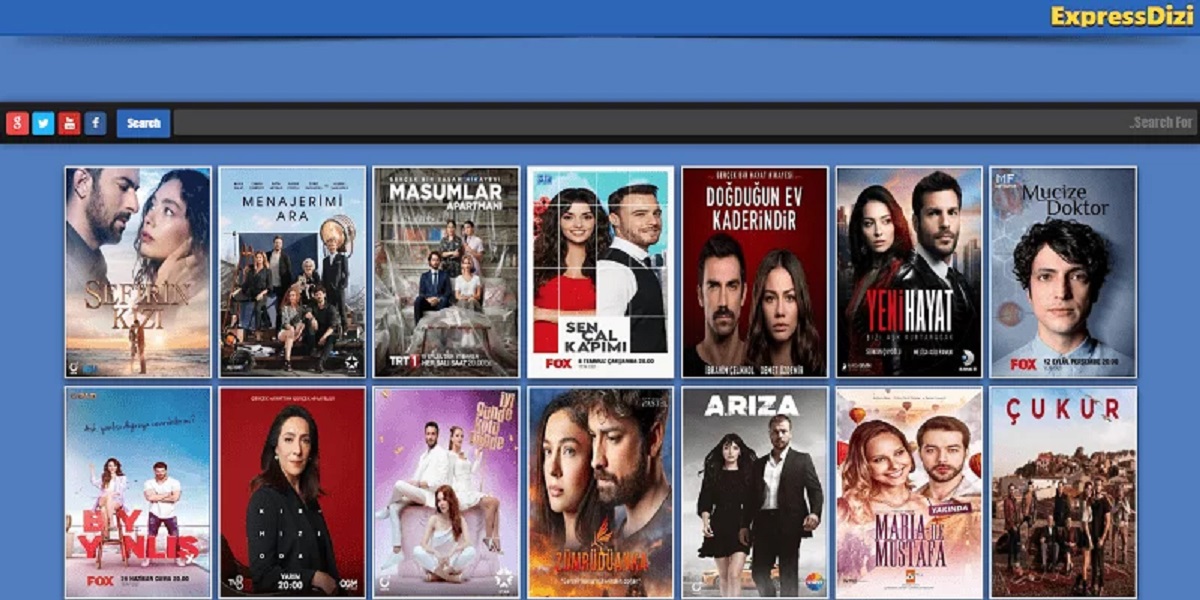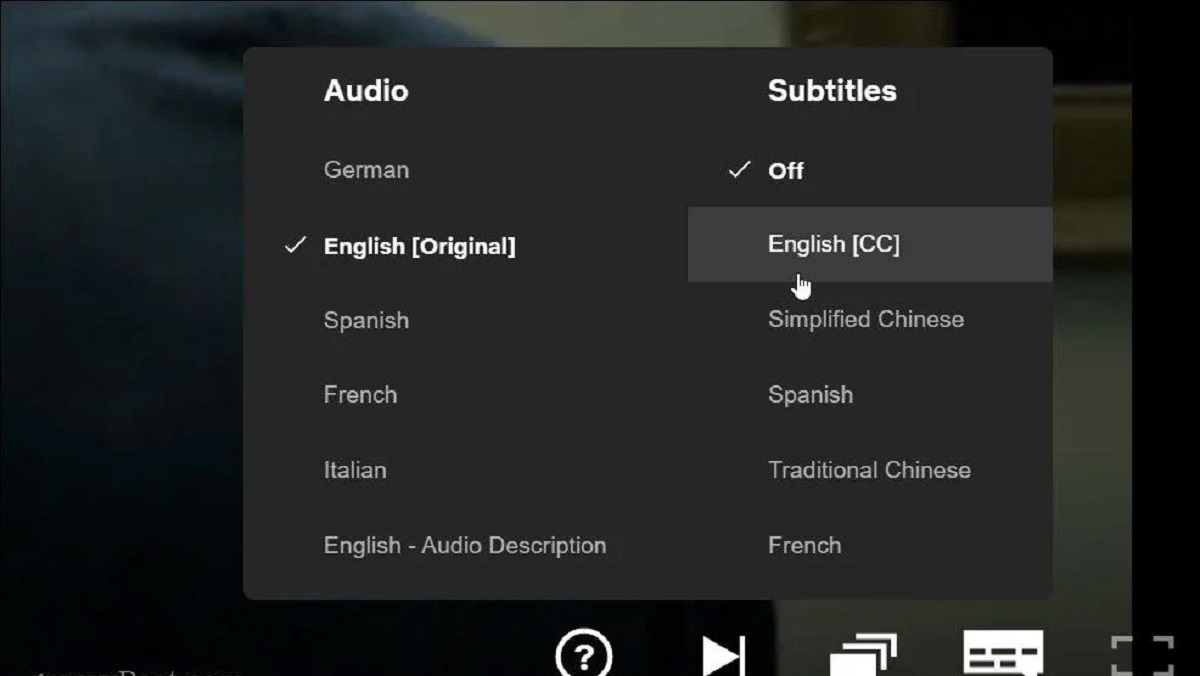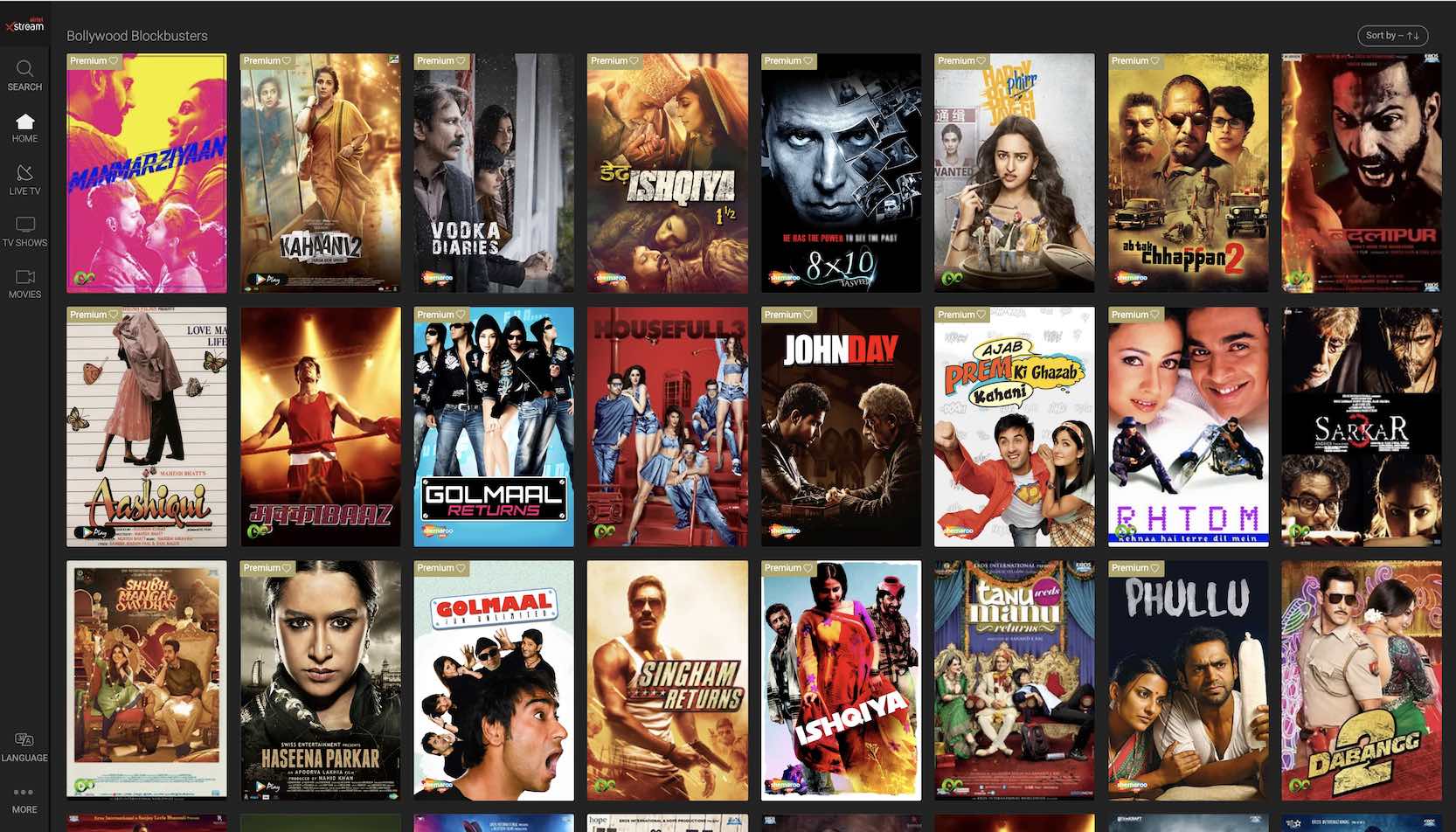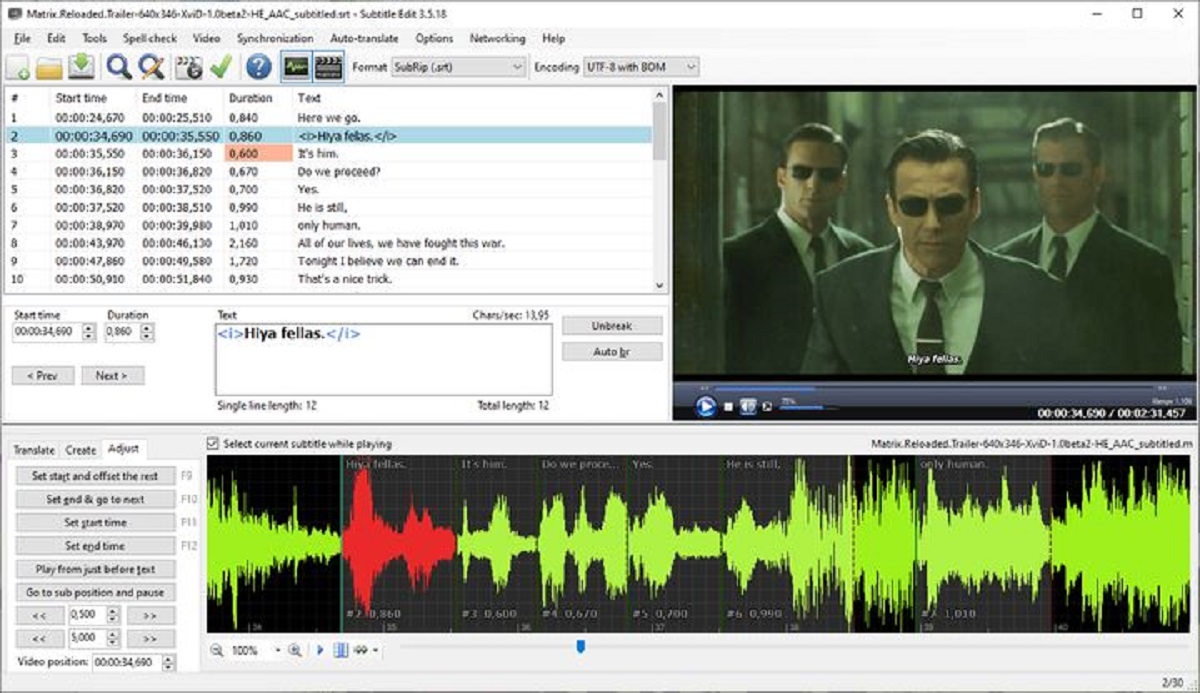Introduction
Adding English subtitles to videos has become increasingly important in the digital age. Whether you are creating videos for social media, online courses, or marketing purposes, subtitles can significantly enhance the viewer’s experience and widen your reach to a global audience.
English subtitles provide a written representation of the dialogue, allowing viewers to understand the content even if English is not their first language or if they have hearing impairments. Subtitles not only improve accessibility but also cater to those who prefer to watch videos in sound-sensitive environments or without audio altogether.
Moreover, adding English subtitles can boost your video’s search engine optimization (SEO). Search algorithms can crawl and index the text of subtitles, enabling your video to appear in relevant search results. This can lead to higher visibility and increased organic traffic to your content.
In this article, we will guide you through the process of creating and adding English subtitles to your videos. We will cover everything from transcription and translation to formatting and synchronization. Additionally, we will explore various methods and tools to help you add subtitles effectively.
By the end of this article, you will have the knowledge and tools necessary to create and add English subtitles to your videos, unlocking new possibilities for engagement, inclusivity, and SEO impact.
Importance of English Subtitles
English subtitles play a crucial role in ensuring effective communication and accessibility in the digital world. Here are several reasons why adding English subtitles to your videos is essential:
- Enhanced Accessibility: English subtitles make your videos accessible to a broader audience, including those with hearing impairments or those who speak English as a second language. Subtitles allow everyone to follow along with the dialogue and fully understand the content.
- Increased Viewer Engagement: With subtitles, viewers can engage with your video content more deeply. They can read and comprehend the spoken words while watching the visuals simultaneously. This multi-sensory experience can lead to better comprehension and retention of the information presented.
- Improved User Experience: By offering subtitles, you provide viewers with the flexibility to watch your videos in various environments, such as noisy public spaces or places where audio may not be allowed. Subtitles ensure that the message of your video is conveyed clearly, regardless of the external circumstances.
- Expanded Reach: English subtitles enable your videos to reach a global audience. They break down language barriers and allow non-English speakers to engage with your content. This can result in increased engagement, social sharing, and potential collaborations with individuals or businesses from different regions.
- Enhanced SEO: Subtitles can significantly impact your video’s search engine optimization. By including accurate subtitles, search engine algorithms can index and rank your content based on its textual content. This can lead to higher visibility in search results and attract organic traffic to your video.
By recognizing the importance of English subtitles, you can ensure that your video content is accessible, engaging, and inclusive to a wide range of viewers. In the following sections, we will explore the step-by-step process of creating and adding English subtitles to your videos, as well as the best practices to follow along the way.
How to Create English Subtitles
Creating English subtitles for your videos involves a series of steps, from transcribing the dialogue to formatting and syncing the subtitles. Let’s walk through the process:
Step 1: Transcribe the Dialogue: Begin by transcribing the spoken dialogue of your video. Listen carefully and convert the spoken words into written text. Make sure to capture all the important details, including pauses, background noises, and non-verbal sounds that contribute to the overall understanding of the video.
Step 2: Translate the Dialogue: If your video is in a language other than English, it’s necessary to translate the transcribed dialogue into English. Ensure the translation accurately conveys the intended meaning and maintains the same tone and context as the original dialogue.
Step 3: Subtitle Formatting: Format the subtitles to ensure optimal readability and synchronization. Divide the dialogue into clear, concise sentences or phrases, and break them into separate lines. Use appropriate punctuation, capitalization, and text formatting to convey the tone and emphasis of the dialogue.
Step 4: Sync the Subtitles: Align the subtitles with the corresponding audio and video. Adjust the timing of each subtitle so that it appears and disappears in sync with the spoken words. Pay attention to the duration the subtitles stay on the screen, ensuring they are readable without feeling rushed or lingering for too long.
Step 5: Adjust and Review Subtitles: Go through the subtitled video multiple times to ensure accuracy, readability, and proper synchronization. Make necessary adjustments to timing, formatting, and any errors or inconsistencies found during the review process. Constantly refer back to the original video to ensure the subtitles accurately capture the essence of the content.
Creating English subtitles for your videos requires attention to detail and precision to ensure the subtitles accurately reflect the spoken words and enhance the viewer’s experience. Once your subtitles are ready, it’s time to add them to your video. In the following sections, we will explore various options and tools for seamlessly incorporating subtitles into your videos.
Step 1: Transcribe the Dialogue
The first step in creating English subtitles for your videos is transcribing the dialogue. Transcribing involves listening to the spoken words in the video and converting them into written text. This process ensures accuracy and captures all the crucial details that need to be conveyed through the subtitles. Follow these steps to transcribe the dialogue effectively:
- Watch and Listen: Watch the video closely while paying attention to the spoken dialogue. Listen carefully to capture all the words, phrases, and nuances of the conversation. It’s important to note any pauses, background noises, or non-verbal sounds that contribute to the overall understanding of the video.
- Use Transcription Software: Utilize transcription software or tools to make the process more efficient. These tools can help you automatically convert spoken words into written text, saving time and reducing the chances of errors. Another option is to use a dictation tool that transcribes your voice as you speak the dialogue.
- Timestamp Important Moments: Timestamp important moments or key events in the dialogue. These timestamps can be used later while syncing the subtitles with the video and help ensure accurate timing.
- Proofread and Edit: After transcribing the entire dialogue, proofread and edit the text. Check for any errors, inconsistencies, or missing words. Ensure the transcription accurately represents the spoken words and maintains the original meaning and context.
- Organize and Structure: Organize the transcribed dialogue in a way that makes it easy to work with during the subtitle creation process. Divide the text into clear, concise sentences or phrases, and separate them into individual lines that fit within the subtitle’s length limitations.
Transcribing the dialogue is a crucial step in creating accurate English subtitles for your videos. It sets the foundation for the subsequent steps of translation, formatting, and synchronization. Paying attention to detail and ensuring the precise capture of the spoken words is vital to producing high-quality subtitles that enhance the viewer’s understanding and engagement with your content.
Step 2: Translate the Dialogue
Once you have transcribed the dialogue, the next step in creating English subtitles for your videos is translating the dialogue into English. This step is crucial if the video content is in a language other than English. Follow these guidelines to ensure an accurate and effective translation:
- Understand the Context: Familiarize yourself with the overall context and tone of the video. Understanding the purpose and theme of the content will help you to accurately translate the dialogue and convey the intended message in English.
- Maintain Meaning and Tone: Ensure that the translation accurately reflects the meaning and intent of the original dialogue. Strive to capture the nuances, emotions, and cultural references while maintaining a natural and understandable flow in the English language.
- Adapt to Cultural Differences: Take into consideration any cultural differences between the source language and English that may affect the translation. Adapt the language and expressions to ensure they are relatable and appropriate for an English-speaking audience.
- Consider Space Limitations: Keep in mind the space limitations for subtitles. Be concise and choose words or phrases that convey the same meaning within the given character limit. Simplify complex sentences, if necessary, while preserving the essence of the original dialogue.
- Proofread and Revise: Once the translation is complete, proofread and revise the text to ensure accuracy and coherence. Verify the translated dialogue against the original transcribed text to ensure that nothing was overlooked or mistranslated.
Accurate translation is essential to convey the intended message and maintain the authenticity of the original content. A well-executed translation enables viewers to fully understand and engage with your video, regardless of their language background. Once the dialogue is successfully translated, you can proceed to the next steps of formatting, syncing, and adding the English subtitles to your video.
Step 3: Subtitle Formatting
After transcribing and translating the dialogue, the next step in creating English subtitles for your videos involves formatting the subtitles. Subtitle formatting ensures that the text is presented in a visually appealing and readable manner. Follow these guidelines to effectively format your subtitles:
- Divide Dialogue into Subtitle Lines: Divide the dialogue into separate lines that fit within the subtitle’s length limitations. Each line should contain a complete thought or phrase to ensure clarity and readability.
- Time Constraints: Consider the timing of the subtitles. Ensure that the text appears and disappears in sync with the corresponding spoken words. Take note of the duration the subtitles stay on the screen, balancing readability with the flow of the video.
- Text Formatting: Use appropriate text formatting to enhance the readability of the subtitles. Use a legible font and size that allows viewers to read the text comfortably. Consider factors such as color, contrast, and outline to ensure the subtitles stand out against the video background.
- Punctuation and Capitalization: Pay attention to punctuation and capitalization to accurately convey the tone and emphasis of the dialogue. Use punctuation marks and capital letters where necessary to reflect the natural flow of the spoken words.
- Consistent Styling: Maintain consistent styling throughout the subtitles for a professional and polished look. Keep the font, size, color, and positioning consistent across all subtitles to provide a cohesive viewing experience.
Effective subtitle formatting is crucial in capturing viewers’ attention and conveying the dialogue seamlessly. By adhering to formatting guidelines and creating visually appealing subtitles, you enhance the overall viewing experience and ensure that viewers can easily connect with your video content.
Step 4: Sync the Subtitles
Once the subtitles are transcribed and formatted, the next step in creating English subtitles for your videos is to sync them with the corresponding audio and video. Proper synchronization ensures that the subtitles appear on the screen in perfect timing with the spoken words. Here’s how you can effectively sync your subtitles:
- Refer to Timestamps: If you timestamped important moments during the transcription process, refer to them now. Use the timestamps as a guide to align the subtitles with specific points in the video, ensuring accurate timing.
- Adjust Subtitle Duration: Pay attention to the duration each subtitle is displayed on the screen. Make sure the text remains readable without feeling rushed or lingering for too long. Adjust the duration of each subtitle if necessary, ensuring a natural flow that aligns with the speaking pace.
- Sync with Audio and Visual Cues: Sync the subtitles with the audio and visual cues in the video. Ensure that the subtitles match the spoken words precisely, appearing on the screen as the dialogue is being spoken. Pay attention to lip movements, gestures, and other visual indicators to enhance the synchronization.
- Smooth Transition between Subtitles: Make sure there is a smooth transition between each subtitle. Avoid abrupt changes or overlaps that may confuse the viewers. Review the subtitles multiple times to ensure a seamless and coherent flow as one subtitle transitions to the next.
- Proofread and Review: After syncing the subtitles, thoroughly review and proofread them. Watch the subtitled video several times to ensure accuracy in timing and synchronization. Take note of any discrepancies or errors and make necessary adjustments.
Syncing the subtitles with the audio and video is a crucial step in creating a seamless viewing experience. Proper synchronization allows viewers to follow along with the dialogue effortlessly and enhances their engagement with your video content.
Step 5: Adjust and Review Subtitles
Once the subtitles are synced with the audio and video, the next step in creating English subtitles for your videos is to adjust and review them. This step ensures the accuracy, readability, and overall quality of the subtitles. Follow these guidelines to effectively adjust and review your subtitles:
- Verify Accuracy: Review the subtitles while watching the video to ensure their accuracy. Verify that the text aligns precisely with the spoken words and accurately conveys the intended meaning. Cross-check the subtitles against the transcribed and translated dialogue to ensure consistency.
- Check Readability: Assess the readability of the subtitles. Ensure that the font size, style, and color allow viewers to read the text comfortably without straining their eyes. Pay attention to the contrast between the text and the video background to maximize legibility.
- Review Timing: Focus on the timing of the subtitles. Check if they appear and disappear on the screen at the intended moments. Adjust the duration of each subtitle if necessary, ensuring they stay on the screen long enough for viewers to read but not linger excessively.
- Fix Errors and Inconsistencies: Look out for any errors, typos, or inconsistencies in the subtitles. Rectify any issues you come across, such as incorrect grammar, punctuation errors, or misspelled words. Ensure that the subtitles maintain a consistent style and adhere to proper language usage.
- Ensure Coherence: Assess the overall coherence and smooth flow of the subtitles. Check that the dialogue is presented in a logical sequence and that the subtitles transition smoothly from one to another. Make sure there are no abrupt changes or disruptions that may confuse or distract the viewers.
Adjusting and reviewing the subtitles is a critical step in delivering high-quality and effective English subtitles for your videos. By ensuring accuracy, readability, and coherence, you provide viewers with a seamless experience that enhances their understanding and engagement with your video content.
How to Add Subtitles to Video
Once you have created and adjusted the English subtitles for your videos, the next step is to add them to your video. There are several methods and tools available to help you effectively incorporate subtitles into your video. Here are three common options:
Option 1: Using Video Editing Software
If you have video editing software, such as Adobe Premiere Pro, Final Cut Pro, or iMovie, you can easily add subtitles to your video. Import your video into the software and locate the “Subtitle” or “Caption” feature. Input the subtitles line by line, matching the timing with the corresponding dialogue. Adjust the font, style, and positioning to ensure optimal readability. Finally, export the video with the embedded subtitles.
Option 2: Using Online Subtitle Tools
Online subtitle tools provide a user-friendly and convenient way to add subtitles to your videos. Platforms like Amara, Subtitle Workshop, and Kapwing allow you to upload your video and then import your subtitle file. The tools will assist you in syncing the subtitles with the video and provide options to customize the appearance of the text. Once the subtitles are properly aligned, you can download the video with the embedded subtitles.
Option 3: Using Subtitle Player Apps
If you prefer to have external subtitles that can be toggled on or off while watching a video, you can use subtitle player apps. These apps, such as VLC Media Player, allow you to add external subtitle files to your video playback. Simply download the subtitle file corresponding to your video and ensure that the file name matches the video file. When you play the video using the subtitle player app, it will automatically display the subtitles.
Choose the option that best suits your needs and the tools at your disposal. Adding subtitles to your videos not only enhances accessibility but also improves viewer engagement and searchability. By including accurate and well-designed subtitles, you provide an inclusive experience for a wider audience and increase the impact and reach of your video content.
Option 1: Using Video Editing Software
One effective way to add subtitles to your videos is by using video editing software. This option gives you full control over the placement, appearance, and timing of the subtitles. Here’s how you can add subtitles using video editing software:
- Step 1: Import your video: Open your video editing software and import the video you want to add subtitles to. Most editing software supports various video file formats, making it easy to work with your preferred format.
- Step 2: Access the subtitle feature: Locate the “Subtitle” or “Caption” feature in the software. This feature allows you to input text and customize the appearance of the subtitles.
- Step 3: Input the subtitles: Input the subtitles line by line, following the timing of the corresponding dialogue. Most software provides a timeline or grid for precise placement. Ensure that the subtitles are synchronized accurately with the spoken words in the video.
- Step 4: Customize the appearance: Customize the appearance of the subtitles to ensure optimal readability. Adjust the font type, size, color, and style to match the overall look and feel of your video. Consider choosing a font and size that are easy to read on different screen sizes.
- Step 5: Preview and fine-tune: Preview your video with the subtitles and make any necessary corrections or adjustments. Check for any timing inconsistencies, misspelled words, or formatting issues. Fine-tune the subtitles until they align perfectly with the dialogue.
- Step 6: Export the video with subtitles: Once you are satisfied with the subtitles, export the video with the embedded subtitles. Choose the appropriate video format and settings for your desired output, keeping in mind the platforms or devices you intend to share the video on.
Using video editing software to add subtitles gives you the flexibility to create professional-looking and accurately timed subtitles. It allows for precise control over the placement and appearance of the subtitles, ensuring a seamless integration with your video content.
Remember to familiarize yourself with the specific features and functionalities of your chosen video editing software. Each software may have slight variations in its user interface and subtitle capabilities. With practice and experimentation, you will be able to add subtitles with ease, enhancing the accessibility and impact of your videos.
Option 2: Using Online Subtitle Tools
If you’re looking for a convenient and user-friendly way to add subtitles to your videos, online subtitle tools can be a great option. These tools offer a simple and accessible way to create and incorporate subtitles into your videos. Here’s how you can use online subtitle tools:
- Step 1: Choose an online subtitle tool: There are several online subtitle tools available, such as Amara, Subtitle Workshop, and Kapwing. Explore different tools and select the one that best fits your needs and preferences.
- Step 2: Upload your video: Once you’ve chosen the online subtitle tool, upload your video to the tool’s platform. Ensure that the video file format is compatible with the chosen tool.
- Step 3: Import the subtitle file: Create a subtitle file that includes the transcribed and adjusted subtitles for your video. Most online tools support subtitle file formats like SRT (SubRip Subtitle) or VTT (WebVTT) files. Import the subtitle file into the online tool.
- Step 4: Sync the subtitles: Use the online tool’s interface to synchronize the subtitles with the video. Many tools provide a visual timeline or a synchronized text box where you can adjust the timing of each subtitle line to match the corresponding dialogue in the video.
- Step 5: Customize the appearance: Some online tools allow you to customize the appearance of the subtitles. You can change the font, size, color, and position of the subtitles to best suit your video’s aesthetics and readability.
- Step 6: Preview and download the subtitled video: After synchronizing and customizing the subtitles, preview the video to ensure everything looks and sounds as intended. If you are satisfied with the results, you can download the subtitled video file directly from the online tool.
Online subtitle tools offer a user-friendly and efficient way to add subtitles to your videos. They eliminate the need for complex software installations and allow for easy collaboration if multiple individuals are involved in the subtitle creation process. These tools provide a convenient solution, especially if you are working on a limited budget, have time constraints, or prefer a hassle-free approach to incorporating subtitles into your videos.
Remember to explore different online subtitle tools to find the one that best suits your needs and offers the features you require. Each tool may have variations in its interface and functionalities, so take the time to understand and make the most of the tools available to you.
Option 3: Using Subtitle Player Apps
If you prefer to have external subtitles that can be toggled on or off while watching a video, subtitle player apps provide a convenient solution. These apps allow you to add external subtitle files to your video playback, enabling viewers to choose whether or not they want to view the subtitles. Here’s how you can use subtitle player apps:
- Step 1: Choose a subtitle player app: There are various subtitle player apps available, such as VLC Media Player, MX Player, and KMPlayer. Explore different apps and select the one that suits your device and preferences.
- Step 2: Download the subtitle file: Locate and download the external subtitle file that corresponds to your video. Subtitle files typically have extensions like SRT (SubRip Subtitle) or VTT (WebVTT).
- Step 3: Ensure matching file names: To ensure compatibility, ensure that the subtitle file has the same name as your video file. Both files should be saved in the same location on your device.
- Step 4: Open the video with the subtitle player app: Open the video file using the subtitle player app of your choice. The app will automatically detect the presence of the subtitle file if the names match and offer the option to enable or disable the subtitles during playback.
- Step 5: Adjust subtitle settings: Depending on the subtitle player app, you may have options to customize the appearance and timing of the subtitles. Explore the app’s settings to adjust the font, size, color, or synchronization of the subtitles according to your preferences.
- Step 6: Enjoy subtitled video playback: Once the video is open in the subtitle player app, you can enjoy watching it with the added subtitles. Viewers have the flexibility to enable or disable the subtitles based on their preference.
Subtitle player apps offer a convenient solution for those who prefer to have external subtitles that can be turned on or off during video playback. This option is especially useful when sharing videos with multilingual audiences or when subtitles are desired only in specific viewing situations.
Remember to choose a subtitle player app that is compatible with your device’s operating system and supports the subtitle file format you are using. Each app may have different features and settings, so explore and customize the app’s functionality to optimize your viewing experience.
Best Practices for Subtitling
When adding subtitles to your videos, it’s important to follow best practices to ensure the highest quality and effectiveness. Here are some best practices to consider when it comes to subtitling:
- Accuracy: Aim for accurate translations and transcriptions. Ensure that the subtitles align precisely with the spoken words, conveying the intended meaning without any distortion or misinterpretation.
- Readability: Prioritize the readability of the subtitles. Choose fonts, sizes, and colors that are easy to read on different devices and screen sizes. Enhance the contrast between the text and the video background to maximize legibility.
- Timing and Synchronization: Pay careful attention to the timing and synchronization of the subtitles. Ensure that the subtitles appear and disappear in sync with the corresponding spoken words. Avoid lingering or rushing the subtitles, maintaining a natural flow throughout the video.
- Language and Grammar: Use proper language and grammar in your subtitles. Adhere to standard spelling, punctuation, and grammar rules. Proofread and edit your subtitles to ensure accuracy, coherence, and consistency.
- Formatting: Apply consistent formatting to your subtitles. Use the same font, size, and style throughout the video. Ensure consistency in positioning, color, and duration to create a professional and polished appearance.
- Avoid Overloading: Be mindful of the amount of text displayed in each subtitle. Avoid overwhelming viewers with too much information or long sentences. Aim for concise and easily digestible subtitles that convey the essence of the dialogue.
- Cultural Considerations: Take cultural considerations into account when translating and formatting the subtitles. Adapt idioms, cultural references, and humor to ensure they are relatable to the target audience without losing the essence of the content.
- Accessibility: Prioritize accessibility by adhering to accessibility guidelines. Consider adding closed captions and audio descriptions for viewers with hearing impairments or visual disabilities. Provide options for font customization and subtitle language selection if possible.
- Consistency: Strive for consistency in your subtitling approach. Ensure that the style, tone, and formatting of the subtitles remain consistent throughout the video. Consistency contributes to a more seamless and engaging viewing experience.
- Quality Assurance: Conduct thorough quality checks of your subtitles. Review them multiple times for accuracy, readability, timing, and formatting. Get feedback from others to ensure the subtitles meet the desired standards before sharing your videos.
By following these best practices, you can create subtitles that enhance the viewers’ understanding, engagement, and accessibility to your video content. Subtitles that are accurate, readable, and well-executed contribute to a positive viewing experience and make your videos more accessible and inclusive for a diverse audience.
Conclusion
Adding English subtitles to your videos is a valuable practice that enhances accessibility, engagement, and search engine optimization (SEO). With a well-executed subtitling process, you can ensure that your video content reaches a wider audience and delivers a more inclusive viewing experience.
We discussed the importance of English subtitles and how they improve accessibility for individuals with hearing impairments and non-native English speakers. Subtitles also contribute to increased viewer engagement, improved user experience, expanded reach, and enhanced SEO impact.
We explored the step-by-step process of creating English subtitles, from transcribing and translating the dialogue to formatting, synchronizing, and reviewing the subtitles. Each step is crucial to the overall quality and accuracy of the subtitles.
We also discussed different options for adding subtitles to your videos, including using video editing software, online subtitle tools, and subtitle player apps. These options offer flexibility and convenience in incorporating subtitles into your videos based on your specific needs and resources.
To ensure the best results, we outlined essential best practices for subtitling, including accuracy, readability, timing and synchronization, language and grammar, formatting, cultural considerations, accessibility, consistency, and quality assurance.
By following these guidelines and continuously refining your subtitling process, you can create high-quality English subtitles that amplify the impact of your video content. Whether you are creating videos for educational purposes, marketing campaigns, or entertainment, the addition of English subtitles opens up new opportunities for connecting with a diverse audience and making your content more accessible to all.







